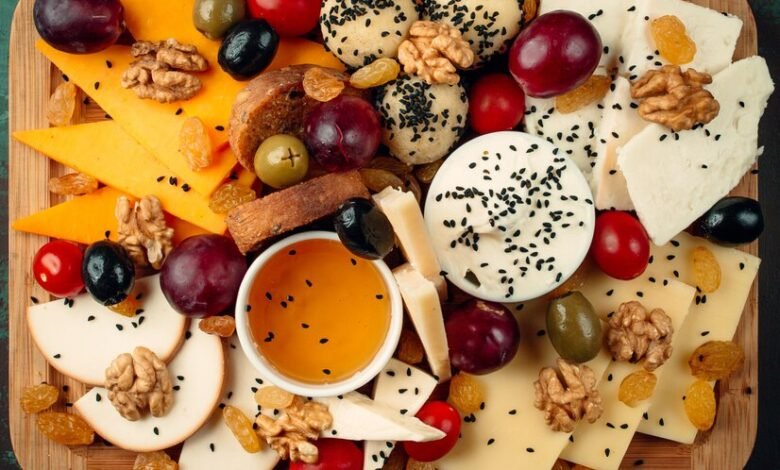Charcuterie Board Ideas: A Fun and Easy Guide to Making Your Own

Are you planning a gathering and looking for a fun and creative way to serve snacks? A charcuterie board ideas could be the perfect solution! It’s a delightful spread of meats, cheeses, fruits, crackers, and other bite-sized treats that not only tastes delicious but looks beautiful too. Plus, charcuterie boards are customizable to fit any occasion and are a great conversation starter.
Whether you’re new to making charcuterie boards or simply looking for fresh ideas, this guide will show you how to create a board that everyone will love. From choosing the right ingredients to arranging them in a visually appealing way, you’ll learn everything you need to make your charcuterie board stand out!
Choosing the Perfect Board
The first step in creating your charcuterie masterpiece is selecting the right board. The board you choose will serve as the foundation for your spread, so it’s important to pick one that’s big enough to hold all your ingredients and matches the style of your gathering.
Boards come in various materials like wood, marble, or slate. Wooden boards are a popular choice because they’re durable and provide a rustic look. Marble boards offer a sleek and elegant vibe, while slate boards provide a modern touch. You can even use a large plate or baking sheet if you’re in a pinch!
Consider the Size of Your Board
Make sure the board is large enough to hold all your items without being too crowded. You want to have enough space to separate the different types of food, while still creating a full and abundant look.
Use Parchment Paper
If you don’t want to place food directly on your board, consider lining it with parchment paper. This is especially helpful if your board is made of porous material like wood and you want to avoid stains.
Selecting Your Meats
A charcuterie board wouldn’t be complete without some tasty meats! The term “charcuterie” itself refers to cured meats, so this is a key component of your board. When selecting meats, aim for a variety of flavors and textures to keep things interesting.
Popular options include:
- Salami: Available in many flavors, from spicy to mild.
- Prosciutto: Thinly sliced and delicate, it adds a salty and savory touch.
- Pepperoni: A familiar favorite with a bit of a kick.
- Chorizo: Spicy and full of flavor, perfect for adding some heat.
How Much Meat Should You Include?

Plan for about 2-3 ounces of meat per guest. If you’re unsure, it’s always better to have a little extra rather than run out too soon!
Adding Cheeses
Cheese is the second star of any charcuterie board. For the best variety, aim to include at least three types of cheese: one soft, one hard, and one bold.
Here are some suggestions:
- Soft cheese: Brie or goat cheese is creamy and easy to spread.
- Hard cheese: Cheddar or gouda offers a sharp or nutty flavor and is perfect for slicing.
- Bold cheese: Blue cheese or Roquefort adds a strong, tangy taste to balance out the milder flavors.
How to Arrange Cheese on Your Board
Cut some of your cheese into slices or cubes before placing it on the board, while leaving other pieces whole for guests to cut themselves. This provides visual interest and makes it easier for guests to serve themselves.
Including Crackers and Bread
Your guests will need something to pair with all that delicious meat and cheese, and that’s where crackers and bread come in! Choose a few different types to add variety.
Some great choices include:
- Water crackers: Thin and crisp, allowing the meats and cheeses to shine.
- Buttery crackers: Add a rich, smooth flavor.
- Baguette slices: Perfect for spreading soft cheeses.
Tip for Bread and Crackers
Avoid using crackers or bread that are too flavorful or seasoned, as they might overpower the other elements of the board. Keep the focus on the meats and cheeses!
Adding Fruits and Vegetables
Fruits and vegetables are not only delicious but add color and freshness to your charcuterie board. They also provide a nice contrast to the rich meats and cheeses.
- Fruits: Grapes, apple slices, and berries are common choices. Dried fruits like apricots or figs also add a chewy texture.
- Vegetables: Try adding slices of cucumber, bell peppers, or baby carrots for a healthy crunch.
Balancing Sweet and Savory
To create a well-balanced board, choose fruits and vegetables that are both sweet (such as grapes) and tart (like pomegranate seeds or pickles). This variety will keep the flavors interesting and balanced.
Don’t Forget the Dips and Spreads
Adding dips and spreads is a great way to bring everything together. They enhance the flavors of your meats, cheeses, and crackers.
Here are some ideas for dips and spreads:
- Savory dips: Hummus, mustard, or olive tapenade.
- Sweet spreads: Honey or fruit preserves.
- Tangy options: Try a chutney or pickles for a sharp, tangy bite.
Sweet and Tangy Accents
Adding a few extra items, like nuts or chocolates, can elevate your charcuterie board even more. These small accents can add sweetness, crunch, and additional textures.
- Sweet accents: Chocolate-covered almonds, truffles, or candied nuts.
- Tangy accents: Pickled onions, olives, or marinated artichokes.
Place these items in small bowls to keep them separate and make it easy for guests to grab a bite.
How to Arrange Your Charcuterie Board

Now that you’ve gathered all your ingredients, it’s time to put everything together! The key to a great charcuterie board is balance and variety. Here are some tips for arranging your board:
- Start with the larger items: Place your cheeses and meats first since they take up the most space.
- Add smaller items: Next, fill in the gaps with fruits, vegetables, and crackers.
- Use small bowls: Place any dips, nuts, or marinated items in small bowls to keep things tidy.
- Garnish for color: If your board looks a little plain, garnish with fresh herbs like rosemary or basil for a pop of color.
Conclusion
Creating a charcuterie board is both an art and a science, but with a little practice, you’ll be a pro in no time! The key is to choose a variety of items that offer different textures, flavors, and colors. Don’t be afraid to experiment and add your own personal touch to the board.
Whether you’re hosting a fancy dinner party or a casual get-together, a charcuterie board is always a hit. With the tips in this guide, you can create a beautiful and delicious spread that will impress all your guests.
FAQs
Q: How much meat and cheese should I include on a charcuterie board?
A: Plan for about 2-3 ounces of meat and cheese per guest to ensure everyone has enough to enjoy.
Q: Can I make a charcuterie board ahead of time?
A: Yes, you can prepare most of your board in advance, but it’s best to add fresh items like fruits and crackers just before serving.
Q: What are some good vegetarian options for a charcuterie board?
A: You can include more cheeses, roasted vegetables, pickles, nuts, and dips like hummus or guacamole for a vegetarian-friendly board.
Q: What should I use to serve dips and spreads on a charcuterie board?
A: Small bowls or ramekins work perfectly for containing dips, spreads, or marinated items to keep the board clean.
Q: How do I store leftovers from a charcuterie board?
A: Wrap any leftover meats and cheeses tightly in plastic wrap or store them in airtight containers to keep them fresh for the next day.
Read More: cpccp in america 3 – ice cream is better



